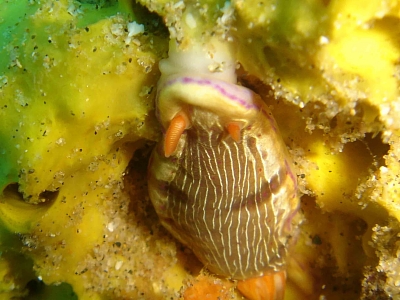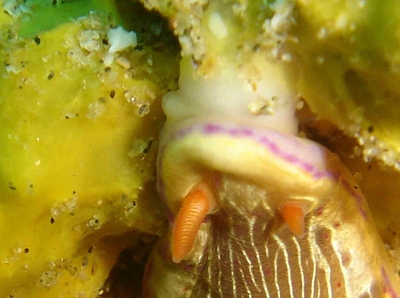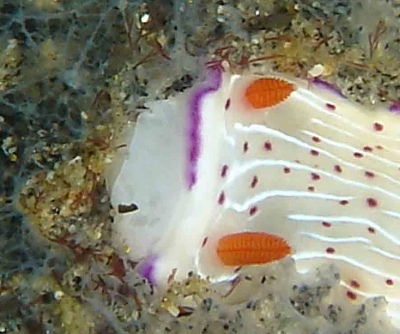Re: Variations in Hypselodoris carnea
April 10, 2008
From: Colin Ogden


Hi Bill,
On a dive a couple of months ago I came across this Hypselodoris carnea [upper photos] feeding on a sponge that appears to me to be different from the sponge in the lower photo, which I sent to you in an earlier message [#15008 ]. We have a huge variation in their colours, and if this is a different sponge maybe their colour variation depends on their food source. I am sorry that I know so little about sponges and just wish that I could improve my knowledge in this field.
Locality: Upper photos: Sodwana Bay, 14 metres, South Africa, Indian, 15 Jan 2008, reef. Length: 40mm. Lower photo: Sodwana Bay, 10 metres. Length: 3 cm. 12 October 2005. sponge algae reef. Photos: Colin Ogden.
best regards
Colin Ogden
scubaco@iafrica.com
Ogden C. M., 2008 (Apr 10) Re: Variations in Hypselodoris carnea. [Message in] Sea Slug Forum. Australian Museum, Sydney. Available from http://www.seaslugforum.net/find/21508
Dear Colin,
It certainly looks as though the brown background colour in your upper photos is from the internal digestive gland and the yellowish band around the mantle edge could possibly be the result of mantle gland contents.
Concerning the yellow sponge which your animal looks to be feeding on. I am afraid I can't see any structural details which I can use. Amost all species of Hypselodoris feed on species of Dysidea, or related genera, and like the sponge in the lower photo the colony has cone-like shapes all over and a radiating pattern and network of structural fibres which are usually quite obvious. Although at times the colonies can be reasonably large and thick, often they consist of a very thin layer over the substrate, or over another sponge colony. It's possible in this case that the sponge the slug is eating is a fine layer over the yellow sponge which we can't really see, but I really can't say. It would be interesting to see what the sponge cover looked like just above the slug? If you have a photo showing just a bit more above the slug it might be useful. As to learning more about sponges, I'm afraid there is not an easily available general book, and no easy way for amateurs - or non-sponge specialists - to identify most sponges. This is for a host of reasons, not the least being that there is still a lot of research needed to sort out sponge taxonomy. Another big problem is that sponge colonies are often very variable in shape and even colour and so species can often only be identified by cutting sections through the tissue for microscopic examination. In sponges with skeletal spicules, we need to examine not only the shape of the spicules, but how they are arranged in the sponge colony. Most sponges eaten by chromodorids present even greater problems because they lack spicules, so we are left with examining the arrangement of the fibrous network to determine species and families. My advice is to try and become familiar with your local sponge fauna even if you can't actually name species. If you find slugs taking a particular interest in particular sponges, keep taking photos of both the sponge and the slug. It is proving an invaluable help.
Thanks very much,
Bill Rudman
Related messages
-
Re: Hypselodoris carnea? from the Gulf of Kutch, India
From: Dishant Parasharya, November 20, 2009 -
Re: Variations in Hypselodoris carnea
From: Colin Ogden, April 14, 2008 -
Re: Thorunna florens from sthn Queensland
From: Colin Ogden, September 28, 2007 -
Hypselodoris carnea from Oman
From: Brian Mayes, April 12, 2007 -
Variations in Hypselodoris carnea
From: Colin Ogden, October 14, 2005 -
Hypselodoris carnea retracting its gills with H.infucata
From: Colin Ogden, September 5, 2005 -
Hypselodoris cf carnea from South Africa
From: Valda Fraser, January 6, 2001 -
Hypselodoris carnea from Oman
From: Gordon T. Smith, December 24, 2000 -
Hypselodoris capensis & H. carnea
From: Bill Rudman, July 28, 2000 -
Re: Hypselodoris carnea v. capensis
From: Terry Gosliner, December 16, 1999 -
Hypselodoris capensis v H. carnea
From: Valda Fraser, December 11, 1999
